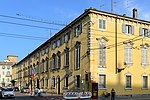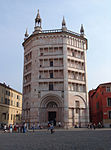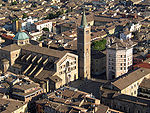Monument to the Fallen, Parma
Buildings and structures completed in 1961Buildings and structures in ParmaMonuments and memorials in Emilia-RomagnaWorld War II memorials in ItalyWorld War I memorials in Italy

The Monument to the Fallen (Italian: Monumento ai caduti) consists of sculptures, reliefs and a plaque affixed in the 1960s to the 18th-century bell-tower (Torre di San Paolo) built attached to the now deconsecrated church of San Ludovico (previously dedicated to San Paolo and serving the adjacent Convent of that name. The bell tower is found at the intersection of Strada Macedonio Melloni, Borgo del Parmigianino, and Strada Cavour in central Parma, Italy.
Excerpt from the Wikipedia article Monument to the Fallen, Parma (License: CC BY-SA 3.0, Authors, Images).Monument to the Fallen, Parma
Borgo del Parmigianino, Parma Parma Centro
Geographical coordinates (GPS) Address Nearby Places Show on map
Geographical coordinates (GPS)
| Latitude | Longitude |
|---|---|
| N 44.80414 ° | E 10.32916 ° |
Address
Borgo del Parmigianino 2a
43121 Parma, Parma Centro
Emilia-Romagna, Italy
Open on Google Maps











